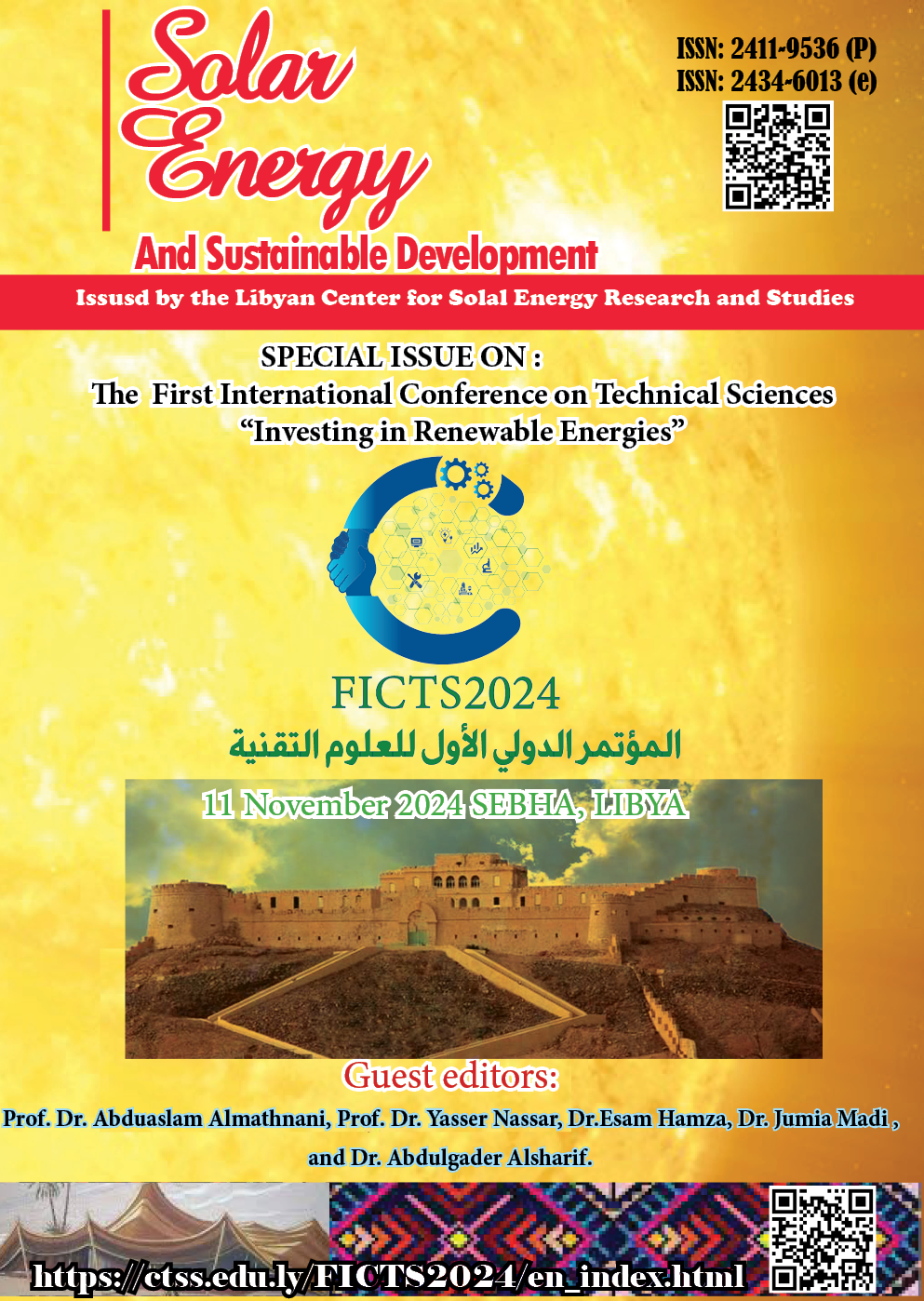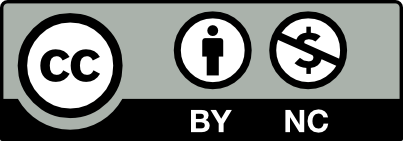Performance analysis of PV Solar Panels Augmented by Plane Reflectors in Elbida-Libya
An Experimental study
DOI:
https://doi.org/10.51646/jsesd.v14iFICTS-2024.443Keywords:
Photovoltaic, Mirror, Cell Temperature, Elbida.Abstract
The goal of this research is to provide an overview of a strategy for optimizing solar panel performance in the presence of solar tracking mirrors in order to optimize energy production. Under Elbieda's climatic conditions, as well as to investigate the fundamental effect of cell temperature on the performance of monocrystalline modules with a mirror reflector. According to the experimental results, the water-cooled concentrating PV system, the concentric PV system, and the solar panel had final plate temperatures of 56.2, 64.7, and 38.4°C, respectively. Furthermore, the panel receives an average of 47.73 watts, or about 56.15% of the panel's power, without the need of the inverter. When using an inverter (mirror), the panel produces an average power of 50.31 watts, accounting for 59.18% of its total power. The average power given to the panel by a water-cooled CPV system is 54.31 watts, or 63.89% of the panel's output. By using the mirror as a reflector and a water-cooled concentrating PV system, the system may create an extra 7.45% and 20.72% of electricity, respectively. In addition, using reflectors and water cooling with the PV panel increased power efficiency from 8.61% to 9.14%.
Downloads
Metrics
References
Hamad, T. A. M. (2015). System integration of hydrogen energy technologies using renewable energy resources. Missouri University of Science and Technology.
Belkhair, A., & Hamad, T. (2019, March). Estimating the Amount of Methane Gas Generated from the Feedstock: A Case Study of El-Beida City, Libya. In 2019 10th International Renewable Energy Congress (IREC) (pp. 1-5). IEEE. DOI: https://doi.org/10.1109/IREC.2019.8754624
Nassar, Y., Alatrash, A., Elzer, R., Alkhazmi, A., El-Khozondar, H., Alsharif, A., ... & Khaleel, M. (2024). Optimum number of glass covers of thermal flat plate solar collectors. Wadi Alshatti University Journal of Pure and Applied Sciences, 2(1), 1-10
Quaschning, V. (2005). Understanding Renewable Energy Systems: Earthscan. ISBN.
Sandén, B. A. (2005). The economic and institutional rationale of PV subsidies. Solar energy, 78(2), 137-146. DOI: https://doi.org/10.1016/j.solener.2004.03.019
Swanson, R. M. (2006). A vision for crystalline silicon photovoltaics. Progress in photovoltaics: Research and Applications, 14(5), 443-453. DOI: https://doi.org/10.1002/pip.709
Hosenuzzaman, M., Rahim, N. A., Selvaraj, J., & Hasanuzzaman, M. (2014, November). Factors affecting the PV based power generation. In 3rd IET International Conference on Clean Energy and Technology (CEAT) 2014 (pp. 1-6). IET. DOI: https://doi.org/10.1049/cp.2014.1467
Dolara, A., Grimaccia, F., Leva, S., Mussetta, M., Faranda, R., & Gualdoni, M. (2012). Performance analysis of a single-axis tracking PV system. IEEE Journal of Photovoltaics, 2(4), 524-531. DOI: https://doi.org/10.1109/JPHOTOV.2012.2202876
Pelaez, S. A., Deline, C., Greenberg, P., Stein, J. S., & Kostuk, R. K. (2019). Model and validation of single-axis tracking with bifacial PV. IEEE Journal of Photovoltaics, 9(3), 715-721. DOI: https://doi.org/10.1109/JPHOTOV.2019.2892872
French, R. H., Murray, M. P., Lin, W. C., Shell, K. A., Brown, S. A., Schuetz, M. A., & Davis, R. J. (2011, May). Solar radiation durability of materials components and systems for low concentration photovoltaic systems. In IEEE 2011 EnergyTech (pp. 1-5). IEEE. DOI: https://doi.org/10.1109/EnergyTech.2011.5948501
Lin, W. C., Hollingshead, D., French, R. H., Shell, K. A., Schuetz, M., & Karas, J. (2012, June). Non-tracked mirror-augmented photovoltaic design and performance. In 2012 38th IEEE Photovoltaic Specialists Conference (pp. 002076-002081). IEEE. DOI: https://doi.org/10.1109/PVSC.2012.6318007
Baccoli, R., Mastino, C. C., Innamorati, R., Serra, L., Curreli, S., Ghiani, E., & Marini, M. (2015). A mathematical model of a solar collector augmented by a flat plate above reflector: Optimum inclination of collector and reflector. Energy Procedia, 81, 205-214. DOI: https://doi.org/10.1016/j.egypro.2015.12.085
Pavlov, M. (2016). Numerical modelling of the coupling of thermal and photoelectric effects for the photovoltaic modules under low concentration (Doctoral dissertation, Université Paris-Saclay).
Simon, S. P., Kumar, K. A., Sundareswaran, K., Nayak, P. S. R., & Padhy, N. P. (2020). Impact and economic assessment on solar PV mirroring system–A feasibility report. Energy Conversion and Management, 203, 112222. DOI: https://doi.org/10.1016/j.enconman.2019.112222
Ahmad, G. E., & Hussein, H. M. S. (2001). Comparative study of PV modules with and without a tilted plane reflector. Energy conversion and management, 42(11), 1327-1333. DOI: https://doi.org/10.1016/S0196-8904(00)00139-4
Tabaei, H., & Ameri, M. (2015). Improving the effectiveness of a photovoltaic water pumping system by using booster reflector and cooling array surface by a film of water. Iranian Journal of Science and Technology Transactions of Mechanical Engineering, 39(M1), 51-60.
Vidanalage, I., & Raahemifar, K. (2016, October). Tilt angle optimization for maximum solar power generation of a solar power plant with mirrors. In 2016 IEEE electrical power and energy conference (EPEC) (pp. 1-5). IEEE. DOI: https://doi.org/10.1109/EPEC.2016.7771795
Hafez, A. A., Nassar, Y. F., Hammdan, M. I., & Alsadi, S. Y. (2020). Technical and economic feasibility of utility-scale solar energy conversion systems in Saudi Arabia. Iranian Journal of Science and Technology, Transactions of Electrical Engineering, 44, 213-225. DOI: https://doi.org/10.1007/s40998-019-00233-3
Nassar, Y. F., & Salem, A. A. (2007). The reliability of the photovoltaic utilization in southern cities of Libya. Desalination, 209(1-3), 86-90. DOI: https://doi.org/10.1016/j.desal.2007.04.013
Sarhaddi, F., Farahat, S., Ajam, H., & Behzadmehr, A. (2010). Exergetic performance assessment of a solar photovoltaic thermal (PV/T) air collector. Energy and Buildings, 42(11), 2184-2199. DOI: https://doi.org/10.1016/j.enbuild.2010.07.011
Downloads
Published
How to Cite
Issue
Section
License
Copyright (c) 2025 Solar Energy and Sustainable Development Journal

This work is licensed under a Creative Commons Attribution-NonCommercial 4.0 International License.














